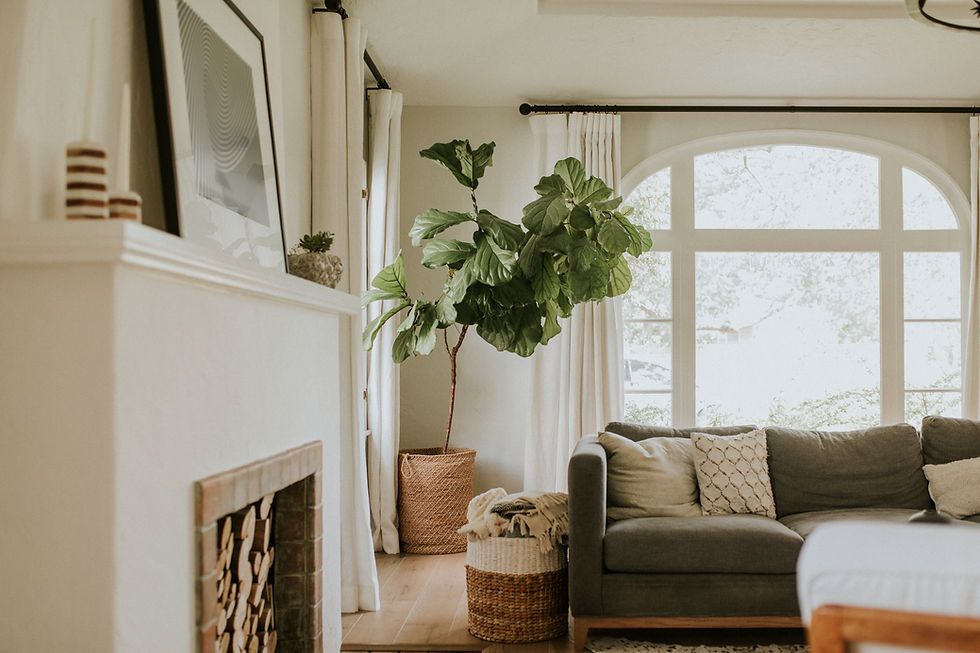Color Combinations in Interior Design: A Foolproof Rule That Always Works
- Ирина Колб

- Sep 25
- 3 min read
A good room design is all about balance: too many colors and it feels chaotic, too few and it feels flat. A simple, universal color combination formula — the 60/30/10 rule — helps create a space that feels stylish and put-together. In this guide, we’ll look at the best color combinations in interior design, explain how the 60/30/10 principle works, and share tips to avoid common mistakes.

The 60/30/10 Rule: Your Easy Formula for Harmony
Designers swear by this rule when building a color palette:
60% — Main ColorThis is your backdrop and sets the overall mood. Usually it’s the wall color, flooring, or other large surfaces like cabinets.
30% — Secondary ColorAdds depth and supports the main color. Think sofa, curtains, an accent wall, or other big pieces of furniture.
10% — Accent ColorThe pops of color that make the room feel alive — throw pillows, artwork, a rug, or decor pieces.
Example in Action
Picture a light-gray living room (60%), a navy sofa with matching curtains (30%), and a couple of yellow pillows (10%). It feels balanced because the proportions are right — not because of any single color.
How to Pick the Right Color Combination
1. Start with a Neutral Base
A neutral background makes it easy to layer colors later. Whites, beiges, grays, and soft pastels create a fresh, open feel and let you change the vibe with just a few accent pieces.
2. Choose a Supporting Color
Pay attention to natural light. If the room doesn’t get much sunlight, go for warm colors — terracotta, olive, warm beige — to make it cozier. If the room is bright and sunny, cooler colors like charcoal, navy, or muted sage can balance things out and prevent the space from looking too yellow.
3. Use Accents Sparingly
Bold colors work best in small doses — pillows, art, vases. This way you can refresh your color palette without repainting the walls.
Easy, Fail-Safe Color Combos
Beige + Gray + Green
Pick a muted green like sage, olive, or moss. Add live plants or green throw pillows to keep the look natural.
White + Blue + Gold
Deep navy or indigo works well for cabinets or textiles, and gold accents shine in hardware, mirror frames, or light fixtures.
Gray + Soft Pink + Black
Stick to dusty or blush pink to avoid a “nursery” vibe. Use black in small details — picture frames, chair legs, light fixtures — to give the room a graphic edge.
Cream + Caramel + Charcoal
Let caramel come through in wood furniture or textiles, and use charcoal in metal finishes or statement ceramics. This mix is perfect for a warm, minimal space.
Common Mistakes to Avoid
Too Many Accents — 10% suddenly turns into 40%, and the room feels noisy.
No Connecting Element — your colors don’t “talk” to each other. For example, warm beige walls with cool gray furniture look disconnected. Fix it with a rug, throw pillows, or artwork that ties both colors together.
Ignoring Texture — even the best palette looks flat if everything is smooth and plain.
Texture: The Secret to a Rich Look
Color is just step one. To make your color combinations look truly polished, mix materials:
wood + metal
textiles + smooth surfaces
matte + glossy finishes
Even with only three colors, a mix of textures can make the room feel layered and high-end.
Color Combinations in Interior Design Made Simple
Three colors are all you need to design a balanced room. Follow the 60/30/10 rule for proportions, play with texture for depth, and start with a neutral base so you can easily adjust later. This way, your home will look curated — without feeling overdesigned.
Need professional help bringing your vision to life? Our Tools and Hands team is ready to assist with painting, drywall, tile installation, and other home improvement projects.


